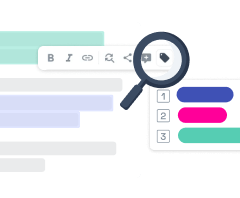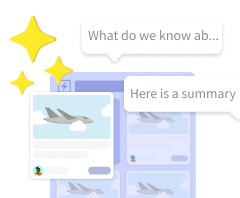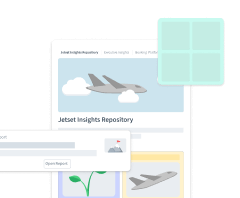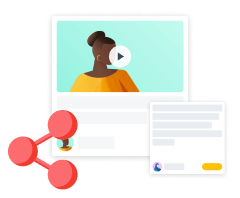
Ask your Session: Analyze Research Data with AI Questions
Research has always started with curiosity. We ask questions, listen closely, and then try to make sense of what we hear. But when it comes to analysis, the process hasn’t always felt as natural.
Traditionally, researchers have had to read through transcripts line by line, tag everything upfront, and only then begin to spot themes. And while this part of the process is often rewarding, it’s also where time disappears.
This is what we set out to change with our September updates. Ask your Session brings AI-powered search into raw data, making it possible to begin analysis the same way research begins: with questions.
Start analysis with AI questions
Think about how you naturally approach a new research project. You don’t start with tags or metadata — you start with questions. What do people find confusing? What motivates them? Where do they get stuck? These are the questions you bring into the interview room, and they’re the same ones that guide you when you begin making sense of your data.
But in the past, you couldn’t act on those questions right away. Before answering them, you had to comb through transcripts, highlight relevant passages, and build a tagging system so you could structure your findings. It works, but it’s heavy. You often end up spending hours setting up the scaffolding of analysis before you can even start answering the questions that matter.
With Ask your Session, that step is no longer a prerequisite.
In short: Ask your Session is an AI-powered search feature in Condens that lets you analyze raw research data by asking natural-language questions. It surfaces relevant quotes, highlights, and suggested tags from your Sessions so you can go directly to the moments that matter, build insights faster, and stay in full control of the analysis.
Here’s what that looks like in practice.
Say you just finished an hour-long interview about a new onboarding flow. Normally, you’d begin by tagging every mention of setup, navigation, or confusion, then later go back and analyze them together. Now, you can start by simply asking: “What did participants struggle with during onboarding?” Condens instantly surfaces the relevant moments, quotes, highlights, and even suggested tags you can accept or refine. Instead of working line by line, you go straight to relevant evidence, using your questions as the entry point.
This doesn’t remove structure from analysis. You can still tag as you go, and in many cases you’ll want to. But the difference is that structure becomes something you add when useful, not something you’re forced to build before you can even begin.
Build insights as you go
One of the most powerful aspects of Ask your Session is how it connects directly into your workflow. Every time you ask a question, the answer block it generates isn’t just a response; it’s a building block. You can drag and drop it straight into an Artifact, like a Report or a Whiteboard, where it turns into evidence clusters you can organize and synthesize.
This means you don’t just get answers; you also start building your insights in parallel. Imagine working through a set of interviews and asking questions like:
“Summarize what participants said about navigation.”
“How did people describe the dashboard?”
“What positive feedback stood out?”
As you go, you’re pulling these answers into your Report, where they cluster automatically. Instead of finishing tagging and then starting to build, you’re doing both at the same time. By the end, you already have the scaffolding of your findings in place — with evidence attached to every point.
Scale analysis across projects
The benefits grow even more once you move beyond a single Session. Often, the slowest part of analysis is comparing across participants. You’ve tagged everything, but now you need to piece together what’s consistent, what varies, and what themes really matter. That usually means revisiting each Session multiple times, repeating searches, and cross-checking tags.
With Ask your Session at the Project level, you can scale the analysis process dramatically. Ask a question once — “What challenges came up during setup?” — and Condens surfaces a consolidated view across all Sessions. Instead of repeating work twelve times for twelve participants, for example, you see the patterns emerge immediately.
Filters make this even sharper. Maybe you want to look only at new users versus experienced ones. Or compare participants in different regions. You can refine the scope of your question so you’re not just casting a wide net, but asking in a focused way that brings out meaningful differences.
Researchers who’ve tested this tell us it can cut their analysis time in half. Not because they’re skipping steps, but because they’re no longer spending hours on repetitive, mechanical work. The effort shifts to where it adds the most value: interpreting evidence and telling the story behind it.
Making research more accessible
Another shift this brings is who can take part in the analysis. For product managers, designers, or other stakeholders, transcripts can be intimidating. They may not know the right keywords to search or the team’s tagging system. Asking in plain language changes that.
Imagine a designer preparing for a sprint review who wants to revisit what participants said about a prototype interaction. Instead of waiting for the researcher to pull a clip, they can ask: “What did people say about the new checkout flow?” and see the relevant quotes right away. Or a product manager planning a roadmap discussion who wonders: “What features did participants request most often?” They can ask the question themselves and come to the meeting armed with evidence.
For researchers, this doesn’t mean losing control. Every answer is tied to real quotes, highlights, and suggested tags — not free-floating summaries. You decide what becomes an insight. But it does mean the rest of the team can engage with the research more directly, which ultimately helps evidence play a bigger role in everyday decisions.
Final thoughts on AI-powered UX Analysis
Analysis has always been where research slows down. It’s necessary, it’s valuable, but it’s also repetitive. We built this feature to remove those unnecessary barriers, so analysis mirrors the way researchers already think and opens the door for more people to engage with user data.
Ask your Session doesn’t change what analysis is about — it changes how you get there. Instead of line-by-line tagging before you can even begin, you start with the questions you already have in mind. The system surfaces the evidence, you build structure as you go, and insights emerge faster. Crucially, it doesn’t automate away judgment or interpretation. AI suggests, but you decide.
For researchers, it’s a shortcut that saves time and lets you focus on synthesis. For stakeholders, it’s an approachable way to engage with raw data without needing to know the mechanics behind it. And for everyone, it makes analysis feel closer to the natural flow of research itself: led by curiosity and grounded by evidence.





